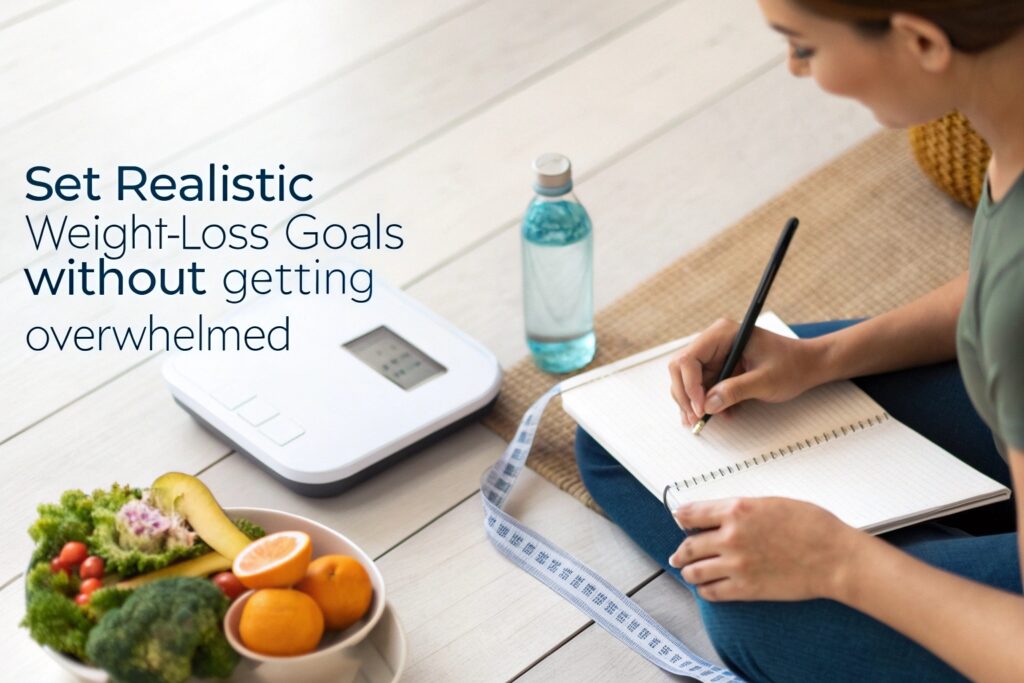Finding the balance between ambition and practicality is the secret sauce to lasting weight‑loss success. Below you’ll discover a step‑by‑step framework, backed by research and real‑world experience, that shows how to set realistic weight‑loss goals without getting overwhelmed.
Introduction
Setting a weight‑loss target can feel like staring at a mountain shrouded in fog. If the summit looks too far away, you may either rush ahead with unsustainable tactics or, worse, abandon the climb altogether. The key is to break the journey into manageable milestones that honor your body’s needs while keeping motivation high. In this guide we’ll explore proven methods, practical tools, and expert insights that let you set realistic weight‑loss goals without feeling swamped by the process.
A realistic plan isn’t about drastic calorie cuts or overnight miracles; it’s about aligning habit change with evidence‑based science, personal lifestyle, and a supportive mindset. By the end of this article you’ll have a clear roadmap, backed by data from reputable sources such as the CDC and the American College of Sports Medicine, that equips you to move forward confidently—one sustainable step at a time.
Section 2 – Understanding the Foundations of Sustainable Weight Loss
1. The Energy Balance Equation: More Than Just Calories
Weight change follows the simple principle of energy balance: calories in vs. calories out. However, the equation is nuanced. Your basal metabolic rate (BMR) accounts for roughly 60‑70 % of daily expenditure, while physical activity, thermic effect of food, and non‑exercise activity thermogenesis (NEAT) complete the picture. A 2022 review in The American Journal of Clinical Nutrition found that a modest 250‑500 kcal daily deficit typically yields 0.5‑1 lb (≈0.2‑0.45 kg) of weekly loss, a rate considered safe by the World Health Organization. Overly aggressive deficits (e.g., >1000 kcal/day) often trigger metabolic adaptation, hormone shifts, and loss of lean muscle, ultimately stalling progress and increasing health risk.
2. Body Composition Matters: Fat vs. Muscle
A realistic goal focuses on body composition, not just the scale. Preserving or building lean muscle while shedding fat improves resting metabolic rate and enhances functional strength. Resistance training, combined with adequate protein (0.8‑1.2 g per kg of body weight for most adults), can offset the muscle‑loss typically associated with calorie restriction. For instance, a 2021 meta‑analysis in Sports Medicine showed that participants who added two strength‑training sessions per week lost 30 % more fat and retained 20 % more muscle compared with diet‑only controls, even when both groups adhered to the same calorie deficit.
Section 3 – Crafting Your Personal Weight‑Loss Blueprint

1. Start With a Baseline Assessment
Before you write any goal, gather objective data: current weight, body‑mass index (BMI), waist circumference, and, if possible, a body‑fat percentage measurement (via bio‑impedance or DEXA). This baseline establishes a reference point and helps you calculate a realistic target. The CDC recommends aiming for a 5‑10 % reduction of body weight for health benefits such as lower blood pressure and improved insulin sensitivity. For a 200‑lb (≈91 kg) individual, that translates to a 10‑20‑lb (≈4.5‑9 kg) loss—far more approachable than the “lose 50 lb in 3 months” myth often seen on social media.
2. Set SMART Goals (Specific, Measurable, Achievable, Relevant, Time‑Bound)
Transform broad intentions into concrete actions. Instead of “I want to lose weight,” craft a goal like: “I will lose 1 lb (≈0.45 kg) per week for the next 12 weeks by creating a 350‑kcal daily deficit through a mix of diet (250 kcal) and exercise (100 kcal).” This structure clarifies what, how much, when, and how you’ll achieve it, reducing ambiguity that often leads to overwhelm. Research from Behavior Research and Therapy (2020) shows that individuals who used SMART goals were 2.5 times more likely to maintain weight‑loss behaviors after six months.
3. Build Micro‑Habits That Compound Over Time
Micro‑habits are tiny, low‑effort actions that become automatic. Examples include drinking a glass of water before each meal, parking two spots farther from the entrance, or adding a 10‑minute walk after dinner. A 2019 study in Health Psychology revealed that participants who adopted three micro‑habits reported a 22 % higher adherence rate to their larger weight‑loss plan compared with those who tried to overhaul multiple habits at once. By focusing on incremental changes, you keep the process flexible and psychologically manageable.
Section 4 – Comparing Common Weight‑Loss Strategies: What Works Best?
1. Low‑Carb vs. Low‑Fat Diets
Both low‑carbohydrate and low‑fat approaches can produce similar weight‑loss results if calorie intake is matched. A 2021 systematic review in The Lancet evaluated 30 randomized trials and found no significant difference in weight change after 12 months. However, individual preferences matter: low‑carb diets may improve satiety for some, while low‑fat plans can be easier to sustain for others who enjoy a broader range of foods. The best strategy is the one you can stick to consistently, combined with adequate nutrient density.
2. Intermittent Fasting (IF) vs. Continuous Calorie Restriction (CCR)
Intermittent fasting, such as the 16:8 method, limits eating to an 8‑hour window and can simplify meal planning. Studies (e.g., Nutrients 2022) show IF yields comparable weight loss to CCR when total weekly calories are identical. The main advantage of IF is often psychological—fewer decisions about “when” to eat—rather than a metabolic boost. Yet, IF may be unsuitable for individuals with a history of disordered eating or those who need steady glucose levels for medical reasons. Choose the pattern that aligns with daily routines and health status.
3. Technology‑Assisted Programs vs. Traditional Coaching
Digital tools like calorie‑tracking apps, wearable fitness trackers, and AI‑powered nutrition platforms have democratized weight‑loss support. A 2023 meta‑analysis in Journal of Medical Internet Research reported that participants using smartphone tracking lost an average of 3.5 % more body weight than those relying solely on paper logs. However, personalized coaching (in‑person or virtual) adds accountability, tailored feedback, and behavior‑change expertise. For many, a hybrid model—using technology for data collection and a certified trainer or dietitian for interpretation—offers the strongest outcomes.
Section 5 – Practical Tools & Step‑by‑Step Guide to Implement Your Goal
1. Choose the Right Tracking Method
Start by selecting a reliable calorie‑tracking app (MyFitnessPal, Cronometer, or Lose It!). Input your baseline data and set the daily calorie target derived from your desired deficit. These platforms also provide macronutrient breakdowns, helping you stay within protein goals that protect lean mass. For those who prefer minimal tech, a simple spreadsheet with daily entries works just as well—consistency is the key driver of awareness and adjustment.
2. Build a Weekly Meal‑Prep Routine
Allocate 2‑3 hours each weekend to batch‑cook lean proteins (chicken breast, tofu, lentils), complex carbs (brown rice, quinoa), and vegetables. Portion these into containers with pre‑calculated calorie counts. A 2020 report from the Academy of Nutrition and Dietetics found that individuals who prepared meals in advance consumed 23 % fewer calories on average than those who cooked ad‑hoc. Meal prepping reduces decision fatigue, limits exposure to high‑calorie temptations, and aligns with the micro‑habit principle.
3. Integrate Activity in Everyday Life
Aim for at least 150 minutes of moderate‑intensity aerobic activity per week (e.g., brisk walking, cycling) alongside two strength‑training sessions. Use a wearable (Fitbit, Apple Watch) to monitor steps and heart‑rate zones; set a daily goal of 8,000‑10,000 steps to increase NEAT. Incremental activity—taking the stairs, standing while on video calls—adds up. The American College of Sports Medicine recommends progressive overload for resistance work: start with 2 sets of 10‑12 repetitions, then gradually increase weight or volume as strength improves.
4. Review, Reflect, and Refine Every 2‑4 Weeks
Schedule a brief “progress check” at the end of each 2‑week cycle. Compare actual weight, measurements, and adherence rates against your plan. If you’re off‑track, identify barriers (e.g., unrealistic meal portions, missed workouts) and adjust. Small, data‑driven tweaks prevent the feeling of stagnation that often leads to overwhelm. A 2018 study in Obesity reported that participants who performed regular self‑monitoring and made iterative changes maintained weight loss significantly longer than those who set static goals
5. Leverage Community Support
Join a reputable online forum (e.g., MyFitnessPal community, Reddit’s r/loseit) or a local wellness group. Sharing successes, asking for advice, and offering encouragement creates accountability and reduces isolation. Social support is consistently linked to better adherence; a 2019 review in Psychology of Sport and Exercise highlighted that participants with a supportive network were 1.9 times more likely to achieve their weight‑loss targets.
Section 6 – Overcoming Common Pitfalls & Final Thoughts
1. The “All‑Or‑Nothing” Mentality
Many beginners fall into the trap of believing that a single slip‑up nullifies weeks of effort. This dichotomous thinking fuels overwhelm and can derail progress. Instead, adopt a “reset, don’t quit” mindset: a missed workout or an extra slice of pizza is a data point, not a disaster. Research from Frontiers in Psychology (2021) shows that individuals who practiced self‑compassion were 30 % more likely to resume healthy behaviors after lapses.
2. Ignoring Psychological Triggers
Emotional eating, stress, and boredom often masquerade as hunger. Developing awareness through mindful eating practices—slow chewing, checking hunger cues before serving—helps differentiate true physiological need from emotional cravings. A 2022 randomized trial in Appetite demonstrated that participants trained in mindful eating lost 1.4 kg more over 12 weeks than controls, largely due to reduced caloric intake during stress episodes.
3. Setting Goals That Are Too Vague or Too Ambitious
Over‑ambitious goals (“lose 30 lb in 4 weeks”) create pressure and increase dropout risk. Conversely, vague goals (“eat healthier”) lack measurable criteria, making it hard to track progress. Align your objectives with the SMART framework, and periodically revisit them to ensure they remain realistic as your fitness level evolves.
Conclusion & Call‑to‑Action
Setting realistic weight‑loss goals without getting overwhelmed is a blend of science, self‑knowledge, and incremental habit formation. By grounding your plan in energy‑balance fundamentals, using SMART goals, embracing micro‑habits, and leveraging supportive tools, you create a resilient roadmap that adapts to life’s inevitable ups and downs.
Ready to start your journey? Download our free “30‑Day Realistic Weight‑Loss Planner”, share your milestones in the comments below, and join our community of motivated changemakers. If you found this article helpful, please share it on social media and explore our related posts on “Healthy Meal Planning” and “Effective Home Workouts for Beginners.” Together, we’ll turn realistic goals into lasting results.



